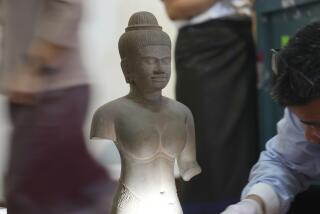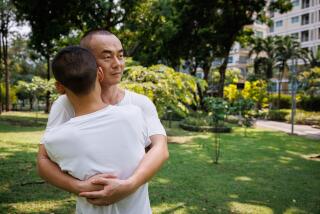An Asian kingdom reveals its enigmatic treasures
- Share via
San Francisco — In 1685 French King Louis XIV sent an ambassador to the kingdom of Siam, which was ruled from a spectacular capital called Ayutthaya, upriver from present-day Bangkok. Surrounded by water, Ayutthaya was a wealthy, cosmopolitan city of soaring temples and palaces, where giant gilt Buddhas glowed as far as the eye could see.
“I had never seen so many idols and so much gold,” wrote the ambassador, the Chevalier de Chaumont. “There is no city in the Orient where one sees so many different nationalities as in the capital city of Siam and where one speaks so many different languages.”
Ayutthaya (ah-YOOT-tah-yah) was one of the great civilizations of Southeast Asia, lasting for more than four centuries. Yet today the kingdom is practically unknown outside Thailand, overshadowed by the rival empires of Angkor and Pagan, in what are today Cambodia and Burma.
“The Kingdom of Siam,” an exhibition at the Asian Art Museum, could change that. The show -- which runs through May 8, then moves to the Peabody Essex Museum in Salem, Mass. -- is the first ever devoted to Ayutthaya, bringing together 89 objects from Thai and Western collections.
“The people of Thailand look back to the era of the kingdom of Siam ... as one of the most important in their history,” Princess Maha Chakri Sirindhorn writes in the exhibition’s catalog. “From modest beginnings, the kingdom grew to be one of the largest and most prosperous in Southeast Asia.”
The show opens with two fascinating giant stone Buddha faces (circa 1374), enigmas that hint at the fragmentary knowledge of Ayutthaya and underscore how much is unknown about the kingdom. Both faces are a few feet high, tightly cropped from the eyebrows to the chin, half the stone on each nose missing. The original statues must have been more than 20 feet tall, probably covered in stucco and gilded. What they looked like in situ one can only guess.
The same is true of Ayutthaya, today a sprawling, fascinating series of ruined temple complexes and headless Buddhas that can be visited as a day trip from Bangkok. Ayutthaya was founded in 1351 and prospered until 1767, when the Burmese sacked and plundered the kingdom, destroying many of its treasures and most of its records.
Just assembling the exhibition has been fruitful for scholars, led by curators Forrest McGill, from the Asian Art Museum, and M.L. Pattaratorn Chirapravati, a professor at Cal State Sacramento. They discovered that the same artist or workshop might have created temple banner paintings now in the collections of the Asian Art Museum and of the Los Angeles County Museum of Art. And in Bangkok, conservators packed up a walking Buddha sculpture and discovered an inscription on the back of its base dating it to 1375, a rare bit of documentation for a specific work.
Still, little is known of the early kingdom. Even its language is uncertain because of the many ethnic groups -- Thai, Mon, Cambodian, Chinese, Malay -- that lived in the area.
“From the period between the ceremonial founding in 1351 and King Narai’s reign, we have virtually no lacquer, little more than ghosts of paintings, and hardly anything of the ivory, swords, furniture and textiles that sometimes survive from the 18th century,” McGill wrote in a recent article in Arts of Asia magazine. What is known is that this medley of cultural influences cohered into a recognizable Ayutthayan style by the late 14th century, when the two great Buddha heads were carved.
A copper Buddha head (circa 1400-1450) perfectly expresses the kingdom’s artistic ideal of poise: The features are exquisite, delicately rendered, with a hint of sensuality, yet the eyes look down, seeming to gaze inward, not at this world but at another.
But even then the kingdom remained awash in different cultural traditions. Buddhism was the dominant religion (and 95% of the surviving sculptures are Buddhas), but Hinduism was still a strong legacy. King Narai, for example, was named after the Hindu god Vishnu. “Ayutthaya” also comes from the Hindu heavenly city of Ayodhya.
The city, as the French observed, was filled with foreigners. The king sent envoys abroad to Holland in 1608 and to Japan eight years later. The French showed up on their own later that century, hoping to convert the kingdom to Catholicism. They established churches, but their faith did not flourish.
Persian, Portuguese, Dutch, Chinese and Japanese traders all brought their wares to the kingdom, where local artisans absorbed myriad influences. The show displays many manuscript cabinets, which shielded documents from the tropical weather. These lacquered and gilded boxes are decorated with fantastic designs, mythological beasts cavorting amid bizarre landscapes, blending motifs from China and Persia.
While Ayutthaya was often at war with its neighbors (in the 1430s Siam attacked and plundered Angkor; in 1569 Burma briefly captured Ayutthaya), the kingdom still managed to carry on a brisk international trade. Weavers in India, for instance, created textiles especially for the Thai market, adorning rugs with vibrant Siamese motifs.
In 1686 Ayutthaya dispatched its own envoy to France -- along with two shiploads of gifts for the court, such as Chinese porcelain and Persian carpets.
Then in 1767 the Burmese invaded again, sacking Ayutthaya and setting fire to much of what had been created over four centuries.
“The riches of the palace and pagodas became a heap of ashes and ruins: the golden images of the false gods were melted,” wrote French historian Francois-Henri Turpin a few years later. “They made their resentment fall on the inhabitants, whom they burned on the soles of their feet, to make them discover the places where their treasure was hid. They violated their weeping daughters before their eyes.... The fields, as well as the pagodas, were strewed with the dead: nothing was to be seen but carcases floating down the rivers.”
Three years later, a new Thai dynasty arose across the river from what would become Bangkok (the kingdom called itself Siam until 1939, when the name was changed to Thailand).
All the while the plundered kingdom of Ayutthaya kept its secrets. In 1957 looters broke into the temple tower of Ratchaburana and carted off a trove of gold objects, which prompted the government to excavate the temple, or wat. They discovered nine rooms filled with 600 Buddha images and 100,000 votive tablets, all sealed away since 1424 -- the most extensive cache of early artifacts from the kingdom ever found. Several of these pieces are on display.
But perhaps the most striking images come from the reign of King Narai, a period when a love of opulence crept into the depictions of the Buddha. The formerly austere mendicants were replaced by Buddhas wearing crowns and draped in jewels.
These bejeweled Buddhas could well serve as a metaphor for the kingdom’s sense of identity -- what McGill refers to as “a strongly spiritual, if complex and challenging, expression of burgeoning power under unquestioned control.”
Scholars say these statues may conflate sacred images with royal portraits. Or perhaps they refer to a legend of a vain king before whom the Buddha appeared decked out in precious stones, stunning him into enlightenment.
Or not. Like so much else about Ayutthaya, these sculptures remain as mysterious as they are dazzling.
More to Read
Sign up for The Wild
We’ll help you find the best places to hike, bike and run, as well as the perfect silent spots for meditation and yoga.
You may occasionally receive promotional content from the Los Angeles Times.






